Related Research Articles
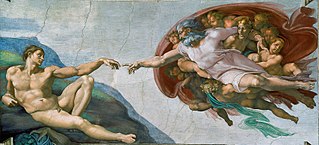
Fresco is a technique of mural painting executed upon freshly laid ("wet") lime plaster. Water is used as the vehicle for the dry-powder pigment to merge with the plaster, and with the setting of the plaster, the painting becomes an integral part of the wall. The word fresco is derived from the Italian adjective fresco meaning "fresh", and may thus be contrasted with fresco-secco or secco mural painting techniques, which are applied to dried plaster, to supplement painting in fresco. The fresco technique has been employed since antiquity and is closely associated with Italian Renaissance painting.

A Roman villa was typically a country house for wealthy people built in the Roman Republic and the Roman Empire.

Gaius Plinius Secundus, called Pliny the Elder, was a Roman author, naturalist and natural philosopher, and naval and army commander of the early Roman Empire, and a friend of the emperor Vespasian. He wrote the encyclopedic Naturalis Historia, which became an editorial model for encyclopedias. He spent most of his spare time studying, writing, and investigating natural and geographic phenomena in the field.
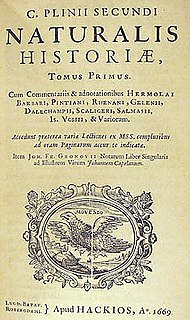
The Natural History is a work by Pliny the Elder. It is one of the largest single works to have survived from the Roman Empire to the modern day and purports to cover all ancient knowledge. The work's subject area is thus not limited to what is today understood by natural history; Pliny himself defines his scope as "the natural world, or life". It is encyclopedic in scope, but its structure is not like that of a modern encyclopedia. It is the only work by Pliny to have survived, and the last that he published. He published the first 10 books in AD 77, but had not made a final revision of the remainder at the time of his death during the AD 79 eruption of Vesuvius. The rest was published posthumously by Pliny's nephew, Pliny the Younger.

The Domus Aurea was a vast landscaped complex built by the Emperor Nero largely on the Oppian Hill in the heart of ancient Rome after the great fire in 64 AD had destroyed a large part of the city.

The Great Fire of Rome, was an urban fire that occurred in July AD 64. The fire began in the merchant shops around Rome's chariot stadium, Circus Maximus, on the night of 18 July. After six days, the fire was brought under control, but before the damage could be assessed, the fire reignited and burned for another three days. In the aftermath of the fire, two thirds of Rome had been destroyed.

The statue of Laocoön and His Sons, also called the Laocoön Group, has been one of the most famous ancient sculptures ever since it was excavated in Rome in 1506 and placed on public display in the Vatican, where it remains. It is very likely the same statue that was praised in the highest terms by the main Roman writer on art, Pliny the Elder. The figures are near life-size and the group is a little over 2 m in height, showing the Trojan priest Laocoön and his sons Antiphantes and Thymbraeus being attacked by sea serpents.
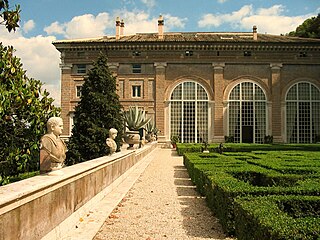
Villa Madama is a Renaissance-style rural palace (villa) located on Via di Villa Madama #250 in Rome, Italy. Located west of the city center and a few miles north of the Vatican, and just south of the Foro Olimpico Stadium. Even though incomplete, this villa with its loggia and segmented columned garden court and its casino with an open center and terraced gardens, was initially planned by Raphael, and highly influential for subsequent architects of the High Renaissance.

Pintoricchio or Pinturicchio whose birth name was Bernardino di Betto, also known as Benetto di Biagio or Sordicchio, was an Italian painter during the Renaissance. Born in Perugia in 1454 and dying in Siena in 1513, Pintoricchio acquired his nickname because of his small stature. He also used it to sign some of his 15th and 16th century artworks.

The art of Ancient Rome, its Republic and later Empire includes architecture, painting, sculpture and mosaic work. Luxury objects in metal-work, gem engraving, ivory carvings, and glass are sometimes considered to be minor forms of Roman art, although they were not considered as such at the time. Sculpture was perhaps considered as the highest form of art by Romans, but figure painting was also highly regarded. A very large body of sculpture has survived from about the 1st century BC onward, though very little from before, but very little painting remains, and probably nothing that a contemporary would have considered to be of the highest quality.
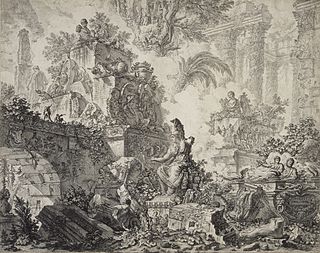
The Baths of Titus or Thermae Titi were public baths (Thermae) built in 81 AD at Rome, by Roman emperor Titus. The baths sat at the base of the Esquiline Hill, an area of parkland and luxury estates which had been taken over by Nero for his Golden House or Domus Aurea. Titus' baths were built in haste, possibly by converting an existing or partly built bathing complex belonging to the reviled Domus Aurea. They were not particularly extensive, and the much larger Baths of Trajan were built immediately adjacent to them at the start of the next century.

Giovanni Nanni, also Giovanni de' Ricamatori, better known as Giovanni da Udine (1487–1564), was an Italian painter and architect born in Udine. A painter also named Giovanni da Udine was exiled from his native city in 1472.
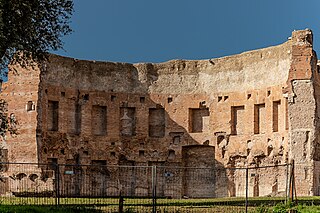
The Baths of Trajan were a massive thermae, a bathing and leisure complex, built in ancient Rome starting from 104 AD and dedicated during the Kalends of July in 109. Commissioned by Emperor Trajan, the complex of baths occupied space on the southern side of the Oppian Hill on the outskirts of what was then the main developed area of the city, although still inside the boundary of the Servian Wall. The architect of the complex is said to be Apollodorus of Damascus. The baths were being utilized mainly as a recreational and social center by Roman citizens, both men and women, as late as the early 5th century. The complex seems to have been deserted soon afterwards as a cemetery dated to the 5th century has been found in front of the northeastern exedra. The baths were thus no longer in use at the time of the siege of Rome by the Ostrogoths in 537; with the destruction of the Roman aqueducts, all thermae were abandoned, as was the whole of the now-waterless Mons Oppius. Early Christian writers misnamed the remains the 'Baths of Domitian'.

The Colossus of Nero was a 30-metre (98 ft) bronze statue that the Emperor Nero created in the vestibule of his Domus Aurea, the imperial villa complex which spanned a large area from the north side of the Palatine Hill, across the Velian ridge to the Esquiline Hill. It was modified by Nero's successors into a statue of the sun god Sol. The statue was eventually moved to a spot outside the Flavian Amphitheatre, which became known, by its proximity to the Colossus, as the Colosseum.
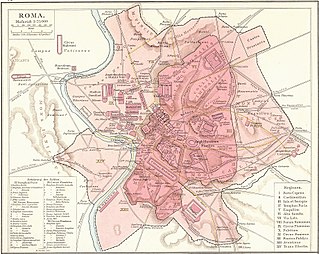
The Flavian Palace, normally known as the Domus Flavia, is part of the vast Palace of Domitian on the Palatine Hill in Rome. It was completed in 92 AD by Emperor Titus Flavius Domitianus, and attributed to his master architect, Rabirius.

Ferraù Fenzoni was an Italian painter and draughtsman. He was a canvas and fresco painter of biblical and religious subjects who worked in a late Mannerist style. He trained and worked in Rome in his youth and later he worked on important commissions in Todi and his native Faenza. He is also called 'Ferraù da Faenza' and 'Il Faenzone' after his birthplace Faenza.
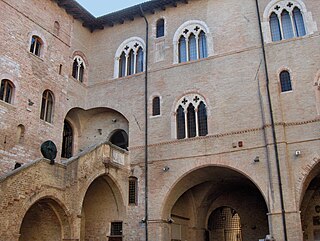
The Trinci Palace is a patrician residence in the center of Foligno, central Italy. It houses an archaeological museum, the city's picture gallery, a multimedia museum of Tournaments and Jousts and the Civic Museum.

The Domus Transitoria was Roman emperor Nero's first palace damaged or destroyed by the Great Fire of Rome in 64 AD, and then extended by his Domus Aurea.

Peiraikos, or Piraeicus, was an Ancient Greek painter of uncertain date and location. None of his work is known to have survived and he is known only from a brief discussion by the Latin author Pliny the Elder. Pliny's passage comes in the middle of his discussion of painting in Book XXXV of his Natural History, completed about 78 AD:
It is well to add an account of the artists who won fame with the brush in painting smaller pictures. Amongst them was Peiraikos. In mastery of his art but few take rank above him, yet by his choice of a path he has perhaps marred his own success, for he followed a humble line, winning however the highest glory that it had to bring. He painted barbers' shops, cobblers' stalls, asses, eatables and similar subjects, earning for himself the name of rhyparographos [painter of dirt/low things]. In these subjects he could give consummate pleasure, selling them for more than other artists received for their large pictures.

Augustan and Julio-Claudian art is the artistic production that took place in the Roman Empire under the reign of Augustus and the Julio-Claudian dynasty, lasting from 44 BC to 69 AD. At that time Roman art developed towards a serene "neoclassicism", which reflected the political aims of Augustus and the Pax Romana, aimed at building a solid and idealized image of the empire.
References
| Look up famulus in Wiktionary, the free dictionary. |
- ↑ Given by some sources as Fabullus; Smith (in his Dictionary of Greek and Roman Biography and Mythology ) argues that Amulius is the more likely.
- 1 2 La Regina, Adriano, ed. (2007) [2004]. Archaeological Guide to Rome. Richard Sadleir (trans.) (New update ed.). Electa. p. 251.
- ↑ Pliny the Elder, Natural History, xxxv.120